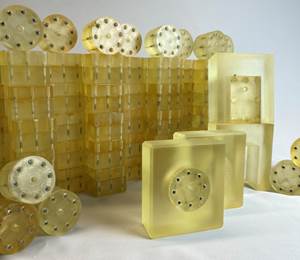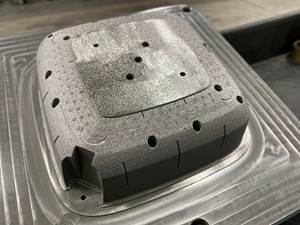3D Printing Provides New Options for Prototyping, Moldmaking
Case Study / Additive Manufacturing.
3-D printing has been a game changer for modeling and rapid prototyping, allowing teams to produce accurate, finely finished parts in just a few hours. It’s emerged as a great alternative to traditional fabrication methods, such as cutting prototypes from wood or metal via woodworking or machine shops.
3-D printing is an additive process—using CAD files, a 3-D printer applies very fine layers of resin, curing as it goes with UV light, until the model is complete. Some advanced printers can jet multiple materials simultaneously creating as many as 11 different mechanical properties in a single model, resulting in a prototype that looks, feels and functions much like the final part that an organization is designing. The prototype is a durable finished piece that can be painted, glued or metal coated, if desired. These advanced printers can produce moving assemblies and parts such as living hinges, in a single build, and are clean enough to run in an office environment.
Milling and machining, by contrast, are subtractive—a model is created by removing material from a block of wood or metal. If too much material is removed, the mold or prototype is ruined and must be scrapped. Because the process can take days or weeks, the cost is much higher, and often that causes businesses to skip prototypes completely and go right from CAD to tooling—meaning design flaws are not identified until manufacturing begins, leading to expensive re-working and lost time.
Research firm Wohlers Associates, which specializes in the rapid prototyping and additive manufacturing markets, reports that spending on additive manufacturing systems totaled $1.068 billion in 2009 with an expected growth of close to $1.2 billion in 2011. This further highlights the fact that more and more businesses are finding this technology valuable.
From the Field
Any company that uses CAD can benefit from 3-D printing. There are two main paths for accessing 3-D printers: via a service bureau, or by purchasing or leasing a system for in-house use.
Access Business Group is the manufacturing arm of $6.3 billion international sales and distribution company Alticor. The company employs more than 3,000 and produces health, beauty, personal care and home care products for their sister company Amway, among others. Access handles both design and manufacturing, and maintains an in-house rapid prototyping lab that serves as an internal service bureau for its designers.
When Access needed a finely detailed prototype in the past, it would outsource the work to a service bureau for its 3-D prints. Eventually, says Mike Kelly, Rapid Prototyping Lab Manager, it made sense to bring a system in house, and Access purchased an Eden350V 3-D printing system from Objet. According to Kelly, “Now we can print out a prototype in just a few hours.”
Soon after purchasing the Eden350V, Access decided to try printing injection-molded inserts with the printer. “We make many of our finished parts using injection molding,” explains Kelly’s colleague Randy Betz, Senior Scientist at Access. “For years, we used SLS to make the molds—the quality was good, but the process took days or even weeks. More and more often, we didn’t have that kind of time. I was looking for a faster alternative.”
Kelly suggested that Betz try making molds using the Eden350V. “We’d been unsuccessful in the past trying to create molds using 3-D printers because of temperature problems, but Objet overcomes those issues,” says Betz. “The molds we’ve created with our Eden350V not only produce highly accurate parts on par with our old molds, but we get them a lot faster—in just a few hours rather than a few days.” Thus, Access now uses its in-house 3-D printing system not only for rapid prototyping but also for moldmaking.
Radio Flyer is another heavy user of 3-D printing technology for both prototypes and molds. Tom Schlegel, Vice President of Product Development for Radio Flyer, reports that the company has been using 3-D printers for years via a service bureau. “We found that rapid prototyping really helped accelerate our design cycles, because we could see and correct problems so quickly,” says Schlegel.
The Radio Flyer team now uses an Objet Eden350V in house for almost all new products, from concept stage all the way through to tooling. “3-D printing plays a crucial role in every part of the product development lifecycle,” says Whiteman. “During our busy season, we run that printer almost around the clock.”
New Business Opportunities
Fawcett Design is a design and product development firm that works with companies such as Fisher Price, The Hoover Company and Rubbermaid. The firm offers design services including new product development and component sourcing as well as prototype services. Jon Fawcett, Manager of Fawcett Design, reports that even as some other areas of his firm’s business have slowed along with the overall economy, its rapid-prototyping business, made possible with Objet’s 3-D printing technology, has continued to grow.
“Many companies can save tens of thousands of dollars and cut months off product development and delivery times by moving to rapid prototyping and rapid manufacturing techniques,” says Fawcett. With its 3-D printer, the company is well positioned to win that type of business.
Related Content
In "Hybrid" FIM Process, 3D Printing Complements Injection Molding
Alpine Advanced Materials used a desktop 3D printer and the freeform injection molding process to reduce prototype tooling production time and cost for its customers.
Read More3D Printing Innovates Hot Runner Manifold Design
Metal 3D printing combined with a conventionally machined manifold block overcomes flow shadows on valve gates and offers faster color changes while providing closer system pitch centerlines between cavities.
Read MoreA 3D Printing Retrospective
A personal review of the evolution of 3D printing in moldmaking throughout the past 25 years.
Read MoreAdvancing Moldmaking and Plastics: Trends in 3D Printing, Automation and Sustainability
NPE 2024 showcased the latest trends and technologies in innovation, efficiency and sustainability for moldmakers and molders, featuring advancements in 3D printing, automation, design and virtual reality/augmented reality/artificial intelligence.
Read MoreRead Next
How to Use Continuing Education to Remain Competitive in Moldmaking
Continued training helps moldmakers make tooling decisions and properly use the latest cutting tool to efficiently machine high-quality molds.
Read MoreHow to Use Strategic Planning Tools, Data to Manage the Human Side of Business
Q&A with Marion Wells, MMT EAB member and founder of Human Asset Management.
Read MoreAre You a Moldmaker Considering 3D Printing? Consider the 3D Printing Workshop at NPE2024
Presentations will cover 3D printing for mold tooling, material innovation, product development, bridge production and full-scale, high-volume additive manufacturing.
Read More

























